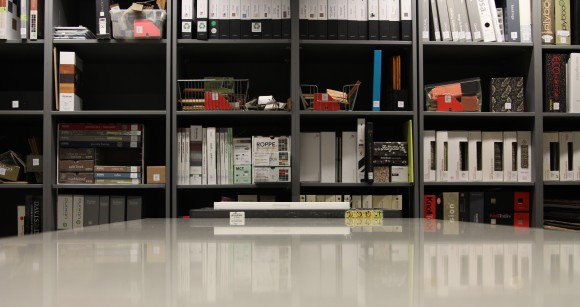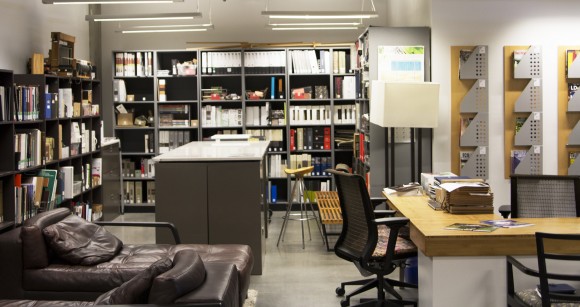Entering the sustainable materials library at UNCG’s Interior Architecture (IARc) Program feels like stepping into a professional architecture firm. While most interior architecture departments have sample rooms stocked with discards and cast off donations from manufacturers, IARc has done something different. Their ever-expanding resource does not simply house materials. It tells stories.
The thoroughly-organized collection of materials is searchable via electronic catalog. Protocol sheets within the catalog detail each material’s sustainability attributes, ranging from production and harvesting practices (for natural products such as bamboo flooring) to toxic chemical content (for paints and fabrics). The catalog even considers factors such as transportation distance when accounting for how “green” a product is. Thanks to the library, students are better equipped to make informed decisions about materials they use for projects and to stay aligned with UNCG’s commitment to sustainability.
 Faculty and students use the ever-expanding library to learn about and interact with materials before incorporating them in projects. “That’s a big part of this resource,” explains Stephanie Brooker, the Faculty Coordinator for the sustainable materials library. “[Students] are able to physically touch and look at the material.”
Faculty and students use the ever-expanding library to learn about and interact with materials before incorporating them in projects. “That’s a big part of this resource,” explains Stephanie Brooker, the Faculty Coordinator for the sustainable materials library. “[Students] are able to physically touch and look at the material.”
In recent years, many professional architectural firms have gotten rid of physical libraries in favor of digital resources, allowing users to access information and materials from all across the globe. UNCG’s physical repository of materials bucks this trend, but with good reason. As Associate Professor Anna Marshall-Baker explains, digital resources have serious drawbacks. “The problem with digital databases, and firms found this too, was that you can’t feel the materials. You can’t see them. You can’t understand the weight; you can’t understand the nap; you can’t feel if the carpet is prickly.”
Having a sustainable materials library at the undergraduate level is unusual. The IARc library is even more unique because it is catalogued through the university library system. Since the Library of Congress has no procedure for organizing this type of inventory, Mary Jane Conger of the UNCG Jackson Library helped establish an unprecedented cataloguing scheme for IARc. The materials library’s catalog is searchable through the UNCG Libraries catalog, with entries including protocol sheets as well as links to material manufacturers’ websites.
The cataloguing scheme integrates a standardized coding system developed by the Construction Specifications Institute (CSI) – an industry standard. All UNCG interior architecture students must learn the CSI system to use the catalog, leaving them better prepared for careers in the field.
 A focus on sustainability issues is growing in the interior architecture industry, and many students are entering programs with green ideas already in mind. “I learned a lot more about what makes a product sustainable, though, after I came to UNCG,” says graduate student Dana Rojack. “I was thrilled when I was first introduced to the library because it was the first interior architecture materials library I had ever seen. I was used to clipping materials [in a sample room]. It was nice to have so much up-to-date materials and literature on hand.”
A focus on sustainability issues is growing in the interior architecture industry, and many students are entering programs with green ideas already in mind. “I learned a lot more about what makes a product sustainable, though, after I came to UNCG,” says graduate student Dana Rojack. “I was thrilled when I was first introduced to the library because it was the first interior architecture materials library I had ever seen. I was used to clipping materials [in a sample room]. It was nice to have so much up-to-date materials and literature on hand.”
While the library itself is intended for student use, the electronic catalog provides valuable information for the community at large. Anybody can access the catalog and protocol sheets. “Homeowners can get on there and look for products such as bamboo flooring and learn about them,” says Dr. Marshall-Baker.
“We are not just making information available on the library site, we are actually generating knowledge,” she adds. Students in IARc’s Materials, Methods, and Technology course must acquire two green materials for the library and complete a protocol sheet detailing the material, manufacturer, life cycle analysis, green qualities or practices, and contact information for those wishing to order samples. The library continually grows as students add about 70 material samples per year. Meanwhile, the students get the opportunity to make an original contribution to their field.
 The library experience goes further than simply allowing students to handle the materials. They also have to contact companies to obtain them. This serves as an important real-world connection between students and company representatives, which can benefit them long after they leave UNCG. “On the job, they are going to be dealing with representatives and ordering materials,” says Dr. Marshall-Baker, “so they learn to do that here.” This hands-on experience of dealing with materials suppliers helps students learn how to be discerning about business practices and sustainability factors because, in the end, they are the decision-makers.
The library experience goes further than simply allowing students to handle the materials. They also have to contact companies to obtain them. This serves as an important real-world connection between students and company representatives, which can benefit them long after they leave UNCG. “On the job, they are going to be dealing with representatives and ordering materials,” says Dr. Marshall-Baker, “so they learn to do that here.” This hands-on experience of dealing with materials suppliers helps students learn how to be discerning about business practices and sustainability factors because, in the end, they are the decision-makers.
The sustainable materials library has the full support of the program’s faculty, staff and students, but it takes significant time and energy. “It’s a lot easier for an interiors program to throw samples in a room and close the door, throw students scissors, and say ‘there you go,’” says Dr. Marshall-Baker. However, Brooker and Marshall-Baker say the resource is worth the effort. “It is a valuable resource for the department. We’ll do everything we can do to keep this up and running.”
To see more images from IARc’s sustainable materials library, click here.
Reposted from the UNCG Office of Research & Economic Development
Photography by Mary McLean
Article author Peter Hess is an Environmental Studies intern working with the UNCG Office of Research and Economic Development. His writing focuses on the important research being conducted by members of the UNCG community. Peter is an environmental studies student in his senior year at UNCG. His passion for communicating science to the public led to his current position.

